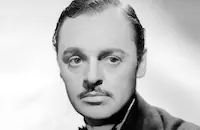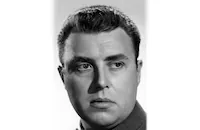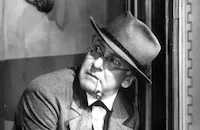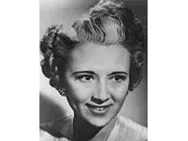Mr. Skeffington

Brief Synopsis
Cast & Crew
Vincent Sherman
Bette Davis
Claude Rains
Walter Abel
George Coulouris
Richard Waring
Film Details
Technical Specs

Synopsis
In 1914, beautiful Fanny Trellis is courted by many men including Jim Conderley, Ed Morrison and Thatcher. One evening, while her suitors wait downstairs, Fanny's cousin, George Trellis, returns home after several years away. George learns that contrary to their extravagant lifestyle, Fanny and her brother Trippy have no money. Trippy, however, now has a job working on Wall Street for Jewish Job Skeffington. Later that evening, Job calls unexpectedly for Trippy, who angrily refuses to see him.
At George's instigation, he and Fanny speak to Job instead. Job has fired Trippy for embezzling and has come to ask him to repay the stolen money. He is stunned when Fanny explains their financial situation. The next day, Trippy threatens to commit suicide. Determined to save her brother, Fanny sets her cap for Job and soon marries him, even though Job fully realizes that Fanny does not love him. Her ploy backfires, however, when an angry Trippy leaves for Europe, and that night, Fanny locks Job out of her room. Fanny's suitors are unfazed by her marriage and continue to pursue her. Job endures their presence because, although Fanny enjoys their attentions, she always sends them away.
On the night of the Skeffingtons' first anniversary, they learn that Trippy has joined the Lafayette Esquadrille and that Fanny is pregnant. Although Job is delighted by the coming child, Fanny sees it as a sign that she is growing old and insists on leaving for California until the baby is born and she is once again beautiful. Shortly after Fanny Junior is born, the U.S. enters the war. When Trippy is killed, Fanny blames Job for his death, and Job finally realizes that Fanny will never love him. After the war ends, Job devotes himself to his daughter, while Fanny occupies herself with a series of lovers. During prohibition, Fanny attracts a bootlegger named MacMahon, who is determined to marry her. To convince her to divorce Job, he demonstrates that Job has had several mistresses during their marriage. Although Fanny's rejection of her husband can be seen as partly responsible for his behavior, Job agrees to a divorce.
Not wanting to be bothered by a child, Fanny suggests that Job take custody of their daughter. Job is reluctant because of the difference in their religions and also because he plans to live in Europe, where the Fascists are coming to power. Fanny Junior's distress at losing her father, however, convinces Job to take her with him. Several years later, a middle-aged Fanny becomes involved with the much younger Johnny Mitchell, and Fanny Junior returns to the U.S. from Berlin. After sailing in stormy weather with Johnny, Fanny falls seriously ill with diphtheria. She recovers, but the illness ages her greatly, and she begins to hallucinate, imagining that she sees Job everywhere. A psychiatrist tells her the hallucinations are a subconscious manifestation of a need to see her former husband because, now that she is fifty, her romantic life is over.
Determined to prove him wrong, Fanny throws a dinner party for her old suitors, only to discover that they are all appalled by her aged appearance. Only Edward still seems smitten, but Fanny quickly realizes that he is only interested in her money. When Fanny Junior later announces that she and Johnny are getting married and moving to Seattle, Fanny is left totally alone. The next morning, George tells Fanny that he has seen Job, now a broken man after his stay in a concentration camp. George begs Fanny to care for Job in return for his generous care of her, but she refuses, believing that her lack of beauty will drive Job away as it did all the others. When she realizes that Job is blind, however, she knows that here is one man who will always remember her as beautiful and welcomes him home.

Director

Vincent Sherman
Cast

Bette Davis

Claude Rains

Walter Abel

George Coulouris

Richard Waring
Marjorie Riordan

Robert Shayne

John Alexander

Jerome Cowan
Johnny Mitchell

Dorothy Peterson

Peter Whitney
Bill Kennedy
Tom Stevenson

Halliwell Hobbes

Walter Kingsford
William Forrest
Harry Bradley
Creighton Hale
John Vosper
Lottie Williams
Vera Lewis
Edward Fielding
Kit Carson
Lucille Lamarr
Joe Devlin
Charles Jordan

Erskine Sanford
Joan Winfield

Ann Doran

Ghislaine Perreau
Dick Erdman
Bunny Sunshine
Charles Marsh
Cyril Ring
Chef Milani

Dolores Gray
Crane Whitley
Hans Herbert

Molly Lamont
Saul Gorss
Sylvia Arslan
Ann Codee
Antonio Filauri
Bruce Warren
Minerva Urecal
Doria Caron
Jack George

Angela Greene
Georgia King
Georgia Caine
Lelah Tyler
Mary Field
Regina Wallace

Bess Flowers
Frances Sage
Janet Barrett

Tom Wilson
Wallis Clark
Richard Kipling
Matt Mchugh
Will Stanton
Tom Quinn
Ronnie Rondell
Patrick Michael Cunning
Danny Dowling
Ray Cooper
Helen Eby-rock
Isabelle Lamal
Dagmar Oakland
Crew
Ralph Dawson
Julius J. Epstein
Julius J. Epstein
Philip G. Epstein
Philip G. Epstein
Leo F. Forbstein
Robert Haas
Ernest Haller
Robert B. Lee
James Leicester
Fred M. Maclean
Orry-kelly
Leonid Raab
Jack L. Warner
Franz Waxman
Perc Westmore

Photo Collections
Videos
Movie Clip




Trailer
Hosted Intro
Film Details
Technical Specs

Award Nominations
Best Actress
Best Supporting Actor
Articles
Mr. Skeffington
On-screen, Davis played a character who ages from headstrong debutante to withered crone, marrying banker Claude Rains for his money along the way. To capture the character's youthfulness in early scenes, she pitched her voice an octave higher than usual. For later scenes, after the character loses her looks to diphtheria, she spent four-hours in the makeup chair while Perc Westmore created an amazingly accurate preview of what she would look like in later years.
Off-screen, Davis was even more of a terror. She had turned the role down when Warner's first bought the property in 1940. The original novel was told mostly in flashbacks, with long scenes of Fanny Skeffington as an old woman discussing her past. Davis didn't think she could play the older woman convincingly. After the role was turned down by everyone from Irene Dunne to Greta Garbo, Davis read a revised treatment that convinced her she could make it work.
A week into pre-production, however, Davis faced personal tragedy when her husband, Arthur Farnsworth, suddenly died. She insisted on returning to work after only one week of mourning, but it was a very different Bette Davis who showed up on the set. Although she was teamed with one of her favorite directors, Vincent Sherman, she started arguing with him the first day of shooting and never quit. When Jack Warner sent a memo to first-time producers Philip and Julius Epstein asking why the picture was falling behind schedule, they shot back, "Because Bette Davis is a slow director."
For his part, Sherman was so miserable that he considered faking a back injury to get out of finishing the film. Instead, he resumed an affair with Davis they had started while making their previous film together, Old Acquaintance(1943). When Sherman confessed the dalliance to his wife, she quipped, "That's one way to solve it [Davis' behavior problems], but be careful."
The affair didn't really solve anything. Mr. Skeffington finally finished production in February 1944, six months after its start date and 59 days behind schedule. That didn't bother Davis' legions of fans, who made the picture one of the top grossers of its year. It also brought Davis her seventh Oscar® nomination for Best Actress.
Director: Vincent Sherman
Producer: Julius J. Epstein, Philip G. Epstein, Jack L. Warner (executive)
Screenplay: Julius J. Epstein, Philip G. Epstein, based on the novel by Elizabeth von Arnim
Cinematography: Ernest Haller
Editor: Ralph Dawson
Art Direction: Robert Haas
Music: Franz Waxman, Paul Dessau (uncredited)
Cast: Bette Davis (Fanny Trellis Skeffington), Claude Rains (Job Skeffington), Walter Abel (George Trellis), George Coulouris (Doctor Byles), Richard Waring (Trippy Trellis).
BW-147m. Close captioning. Descriptive video.
by Frank Miller

Mr. Skeffington
Quotes
A woman is beautiful when she's loved, and only then.- Job Skeffington
Nonsense. A woman is beautiful when she has eight hours' sleep and goes to the beauty parlor every day. And bone structure has a lot to do with it too.- Fanny Trellis Skeffington
You are one of a vast army of silly women. Capital "S," capital "W."- Dr. Byles
Trivia
Notes
A 12 April 1940 Hollywood Reporter news item notes that Selznick-International was bidding for the screen rights to Countess Russell's novel. After Warner Bros. bought the book, a Los Angeles Examiner news item dated October 28, 1941 notes that Tallulah Bankhead, Gloria Swanson and Norma Shearer were all considered to play the role of "Fanny Skeffington." At the time, M-G-M was rumored to be interested in the film as a vehicle for one of that studio's many actresses. Other Hollywood Reporter news items add the following information about the production: Warner Bros. considered Irene Dunne as a possible star for the film. Before his death in 1940, James Stephenson was cast as "Job Skeffington." Later, Paul Henreid was announced for the role opposite Bette Davis. Richard Waring was also tested for the lead, and Faye Emerson and Jean Sullivan were tested for the role of "Fanny Junior." Waring was eventually cast as "Trippy." Charles Drake was scheduled for a part but was drafted, although Hollywood Reporter, Variety and New York Times erronously credit him with the part of "Johnny Mitchell." Instead, actor Johnny Mitchell, who was formerly known as Douglass Drake, made his screen debut in the part. According to studio memos reproduced in a modern source, in 1940, when Bette Davis was initially offered the role of "Fanny Skeffington," she turned it down, believing that as a thirty-two year old woman she could not convincingly play a woman of fifty.
The OWI objected to one version of the script because of its portrayal of American anti-semitism and because American financiers were characterized as "shady." In a letter to Warner Bros., the OWI stated: "This is just the kind of picture of America which the Fascists would like to see. They have deluged the world with propaganda about the money-mad Americans, and today are using this line to create a breach between us and our allies. Is this the picture we want to give other peoples as representative of America and the American way?..." The finished picture still contained the sections the OWI found objectionable.
Modern sources add the following information about the picture: Bette Davis requested Vincent Sherman as her director. Color tests were made, but the studio ultimately decided to make the film in black and white. Shortly after completing Davis' wardrobe of around forty costumes, forty-one-year-old Orry-Kelly was drafted into the army. Bette Davis was nominated for an Oscar for Best Actress and Claude Rains was nominated for Best Supporting Actor. Bette Davis reprised her role in a Lux Radio Theatre broadcast on October 1, 1945, co-starring Paul Henreid.

Miscellaneous Notes
Released in United States December 1996
Released in United States on Video April 5, 1988
Released in United States Summer August 12, 1945
Released in United States on Video April 5, 1988
Released in United States Summer August 12, 1945
Released in United States December 1996 (Shown in Los Angeles (American Cinematheque) as part of program "Contract Man: The Films of Vincent Sherman" December 6-14, 1996.)















